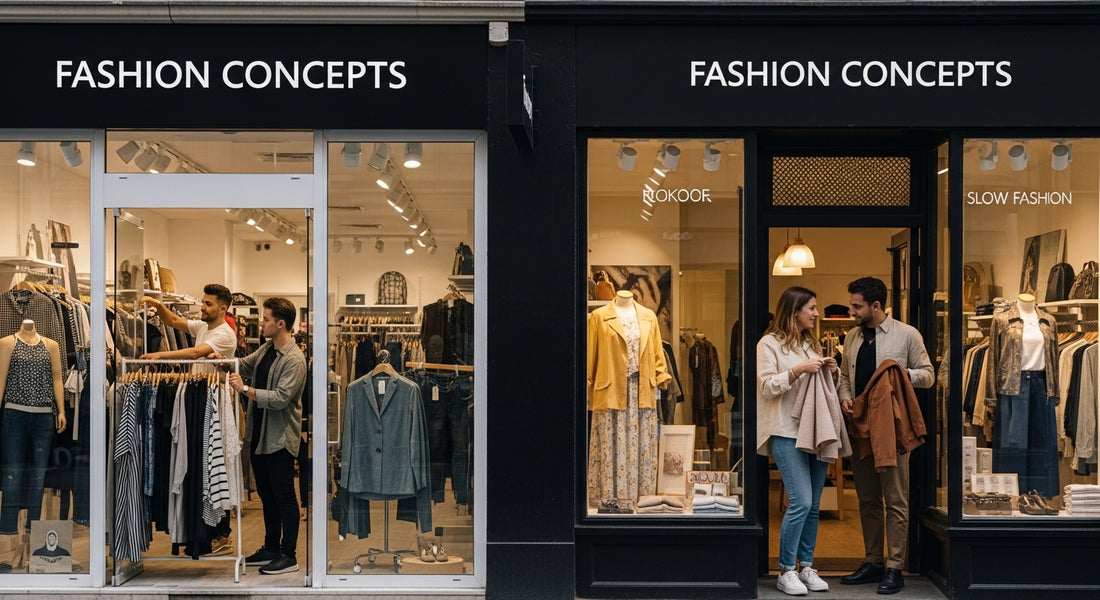
Understanding Slow Fashion vs Fast Fashion: Key Concepts
Share
Every time you buy a new top or trendy pair of jeans, you are making a bigger impact than you think. A single fast fashion purchase might seem harmless, but the industry now produces around 10 percent of all global carbon emissions. It sounds like style and savings rule the high street, but the real cost is worn by the planet and the people behind the scenes.
Table of Contents
- Defining Slow Fashion And Fast Fashion
- The Environmental Impact: Why It Matters
- Cultural And Ethical Considerations In Fashion
- Quality Versus Quantity: The Real Cost Of Fashion
- Choosing Between Slow And Fast Fashion: What To Know
Quick Summary
| Takeaway | Explanation |
|---|---|
| Slow fashion prioritises quality over quantity. | Emphasises the importance of crafting durable, timeless garments instead of a large volume of cheaply made clothing. |
| Fast fashion contributes significantly to environmental damage. | The industry is responsible for about 10% of global carbon emissions and extensive waste generation from disposable clothing. |
| Consumer choices impact ethical practices in fashion. | Purchasing decisions that favour slow fashion challenge exploitative labour practises and promote fair working conditions. |
| Invest in versatile, long-lasting pieces. | Selecting high-quality items reduces waste and aligns with sustainable consumption, promoting a more thoughtful wardrobe. |
| Understand the full cost of clothing. | Recognising hidden economic, social, and environmental costs helps consumers make informed fashion choices that reflect their values. |
Defining Slow Fashion and Fast Fashion
Slow fashion and fast fashion represent two fundamentally different approaches to clothing production, consumption, and philosophy. At their core, these concepts reflect contrasting values about manufacturing, sustainability, and human interaction with clothing.
The Essence of Fast Fashion
Fast fashion emerged as a business model characterised by rapid production cycles, extremely low costs, and high-volume manufacturing. Brands prioritise speed and affordability, creating trend-driven clothing that can be quickly replicated from runway designs and sold at minimal prices. According to Kate Fletcher’s design research, fast fashion fundamentally operates on principles of mass production, minimal quality control, and disposable clothing consumption.
Key characteristics of fast fashion include:
![]()
- Extremely short trend cycles (sometimes changing weekly)
- Low-cost synthetic materials
- Minimal manufacturing ethical standards
- High environmental impact
- Disposable clothing mindset
The Philosophy of Slow Fashion
Slow fashion represents a deliberate counter-movement to the fast fashion model. Rooted in sustainability, ethical production, and quality craftsmanship, slow fashion advocates for conscious consumption. As research from Cambridge University indicates, slow fashion is not just about production speed but about creating a more holistic and responsible approach to clothing design and consumption.
Critical principles of slow fashion include:
- Prioritising quality over quantity
- Using sustainable, natural materials
- Supporting fair labour practices
- Creating timeless, durable designs
- Encouraging mindful consumption
Understanding the difference between slow and fast fashion goes beyond mere aesthetic choices. It represents a profound shift in how we perceive clothing production, environmental responsibility, and our relationship with the garments we wear.
Below is a comparison table highlighting the key differences between slow fashion and fast fashion, summarising their core characteristics for quick reference.
| Aspect | Fast Fashion | Slow Fashion |
|---|---|---|
| Production Speed | Very rapid (weekly trend cycles) | Deliberate and slow-paced |
| Materials | Low-cost synthetics | Sustainable, natural fibres |
| Ethical Standards | Minimal emphasis | Strong focus; supports fair labour |
| Environmental Impact | High pollution, waste, and emissions | Reduced waste, lower carbon footprint |
| Product Quality | Poor; disposable | High; durable and timeless |
| Consumption Mindset | Disposable, trend-driven | Mindful, purpose-driven |
| Price Point | Low, artificially reduced | Reflects true cost and quality |
| Design Philosophy | Replicates trends rapidly | Emphasises longevity and personal style |
The Environmental Impact: Why It Matters
The fashion industry is one of the most significant contributors to global environmental challenges, with fast fashion being a primary driver of ecological destruction. Understanding the intricate relationship between clothing production and environmental sustainability reveals the critical importance of making conscious consumer choices.
Carbon Emissions and Climate Change
Fast fashion’s environmental footprint extends far beyond simple clothing production. According to research from the University of Delaware, the clothing industry contributes approximately 10% of global carbon emissions. These emissions stem from multiple stages of production, including raw material extraction, manufacturing, transportation, and eventual disposal.
Key environmental challenges include:
- Massive water consumption during textile production
- Significant greenhouse gas emissions
- Chemical pollution from synthetic fabric manufacturing
- Extensive waste generation
- Long-term ecosystem disruption
Waste and Resource Depletion
The linear consumption model of fast fashion creates unprecedented waste and resource strain. Clothing items are frequently produced, quickly discarded, and end up in landfills, with synthetic materials taking hundreds of years to decompose. Most garments are worn fewer than ten times before being thrown away, creating a destructive cycle of continuous production and waste.
Consequences of this model involve:
- Millions of tonnes of textile waste annually
- Microplastic pollution in oceans
- Depletion of non-renewable resources
- Increased pressure on global waste management systems
- Accelerated environmental degradation
Choosing slow fashion represents more than a personal style statement it is a direct commitment to environmental preservation and responsible consumption. By selecting high-quality, durable clothing produced through ethical and sustainable methods, consumers can significantly reduce their individual environmental impact and contribute to a more sustainable global fashion ecosystem.
This table outlines the principal environmental and social consequences associated with the fashion industry, distinguishing how fast fashion contributes to each problem.
| Impact Area | Fast Fashion Contribution | Consequence |
|---|---|---|
| Carbon Emissions | High (10% global contribution) | Accelerates climate change |
| Water Usage | Massive consumption | Strains water resources, harms ecosystems |
| Chemical Pollution | Heavy; synthetic fabrics polluted | Damages waterways and ecosystems |
| Textile Waste | Significant; most garments discarded | Landfill build-up and microplastic pollution |
| Labour Rights | Poor working conditions prevalent | Human exploitation and unsafe work environments |
Cultural and Ethical Considerations in Fashion
The fashion industry represents far more than aesthetic choices it embodies complex cultural dynamics, ethical practices, and global economic relationships. Understanding these nuanced interactions reveals the profound social implications of our clothing consumption patterns.
Labour and Human Rights
Fast fashion has systematically exploited labour markets in developing countries, creating a global supply chain built on economic inequalities. According to research from the International Journal of Research and Innovation in Social Science, consumer awareness is increasingly challenging these unethical practices.
Significant ethical challenges include:
- Extremely low wages for textile workers
- Dangerous working conditions
- Child labour practices
- Limited worker protections
- Lack of workplace safety standards
Consumer Consciousness and Social Responsibility
Modern consumers are increasingly recognising their role in driving ethical change within the fashion ecosystem. This shift represents a profound cultural transformation where purchasing decisions become statements of personal values. Slow fashion emerges as a deliberate response to these systemic issues, prioritising transparency, fair compensation, and human dignity throughout production processes.
Key aspects of ethical fashion consumption include:
- Valuing artisan craftsmanship
- Supporting fair trade practices
- Demanding supply chain transparency
- Investing in long-lasting, quality garments
- Recognising the human stories behind clothing
By understanding the cultural and ethical dimensions of fashion, consumers can transform their relationship with clothing from mere consumption to meaningful, responsible engagement. Each purchasing decision becomes an opportunity to support sustainable practices, respect human rights, and contribute to a more equitable global economic system.
Quality Versus Quantity: The Real Cost of Fashion
The fundamental tension between quality and quantity in fashion represents a critical economic and ethical crossroads for modern consumers. This conflict extends beyond mere purchasing decisions, revealing deeper insights into global manufacturing practices, consumer values, and long-term economic sustainability.
The Economic Illusion of Cheap Clothing
Fast fashion creates a compelling economic illusion of affordability that masks significant hidden costs. According to research from the University of Barcelona, the seemingly low prices of mass-produced garments do not accurately reflect their true production and distribution expenses. These artificially reduced prices obscure substantial economic and environmental externalities.
Key economic misconceptions include:
- Artificially low pricing that excludes real production costs
- Exploitation of labour in developing economies
- Environmental damage not factored into product pricing
- Short-term consumer savings versus long-term economic impact
- Hidden social and ecological expenses
The True Value of Quality Manufacturing
Quality manufacturing represents a holistic approach to clothing production that considers durability, craftsmanship, and ethical production. By investing in well-constructed garments, consumers effectively reduce long-term consumption cycles and support more sustainable economic models.
Critical aspects of quality-focused manufacturing involve:

- Superior material selection
- Skilled artisan craftsmanship
- Longer product lifecycle
- Reduced waste generation
- Enhanced economic sustainability for workers
Understanding the real cost of fashion requires moving beyond superficial price tags and recognising the comprehensive economic, social, and environmental implications of our clothing choices. Each garment represents a complex narrative of production, human labour, and ecological impact that extends far beyond its immediate aesthetic value.
Choosing Between Slow and Fast Fashion: What to Know
Navigating the complex landscape of fashion consumption requires a nuanced understanding of personal values, economic realities, and long-term sustainability. Consumers today face increasingly sophisticated choices that extend far beyond simple aesthetic preferences.
Personal Values and Purchasing Decisions
Your clothing choices reflect more than personal style they represent a fundamental statement about your relationship with global production systems. According to research from Corvinus University of Budapest, younger generations are increasingly making purchasing decisions based on deeper ethical considerations beyond mere trend cycles.
Key factors influencing fashion choices include:
- Personal environmental consciousness
- Budget constraints
- Long-term durability requirements
- Ethical production standards
- Individual style philosophy
Strategic Consumption Approaches
Transitioning from a fast fashion mindset to a more intentional approach requires strategic thinking and gradual lifestyle adjustments. This does not necessitate an immediate total wardrobe overhaul, but rather a progressive, mindful approach to clothing acquisition and maintenance.
Strategic consumption strategies involve:
- Investing in versatile, high-quality pieces
- Understanding fabric composition and durability
- Researching brand production practices
- Learning basic clothing repair skills
- Developing a more curated, intentional wardrobe
Choosing between slow and fast fashion is ultimately a personal journey that balances individual economic realities, ethical considerations, and aesthetic preferences. By approaching fashion consumption as a holistic decision-making process, consumers can create meaningful change one garment at a time.
Elevate Your Wardrobe With Timeless Italian Craftsmanship
If the rapid cycle and hidden costs of fast fashion have left you searching for true value and lasting quality, discover a better way to shop. The article has illuminated how fleeting trends and disposable clothing can harm both the planet and garment workers. You deserve classic pieces that combine ethical production, meaningful design, and responsible sourcing. San Rocco Italia shares your principles. Every handbag and accessory is a testament to slow fashion, handcrafted in Italy by skilled artisans with a focus on full-grain leather, longevity, and timeless style.

Move beyond wasteful consumption and invest in items made to last. Explore the San Rocco Italia collection today and see how tradition, quality, and authenticity can transform your approach to fashion. Make a conscious choice to support European craftsmanship and build a wardrobe that reflects your values. Visit San Rocco Italia now and choose luxury with substance.
Frequently Asked Questions
What is the main difference between slow fashion and fast fashion?
Slow fashion focuses on sustainability, quality, and ethical production, while fast fashion prioritises rapid production, low costs, and high-volume manufacturing, often leading to environmental concerns.
How does fast fashion impact the environment?
Fast fashion contributes significantly to environmental issues through high carbon emissions, extensive water consumption, chemical pollution, and substantial textile waste due to its linear consumption model.
Why is quality important in slow fashion?
Quality in slow fashion ensures durability, longevity, and reduced waste generation. It emphasises craftsmanship and sustainable materials, contrasting with the disposable nature of fast fashion garments.
What role do consumers play in promoting slow fashion?
Consumers can promote slow fashion by making mindful purchasing decisions, supporting ethical brands, valuing craftsmanship, and prioritising quality over quantity in their clothing choices.


